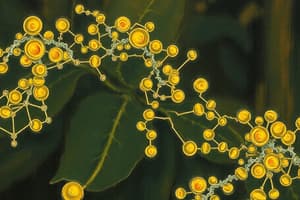Podcast
Questions and Answers
What is a hypothesis?
What is a hypothesis?
- A conclusive explanation with no uncertainties
- An opinion based on personal belief
- A general principle that cannot be tested
- A testable explanation for a set of observations (correct)
Which of the following is NOT a property of life?
Which of the following is NOT a property of life?
- Response to environment
- Growth and development
- Composition of matter (correct)
- Reproduction
Which level of organization is the smallest?
Which level of organization is the smallest?
- Tissues
- Cells
- Organelles (correct)
- Organ systems
What defines a compound?
What defines a compound?
How are water molecules primarily held together?
How are water molecules primarily held together?
What does the atomic number of an atom represent?
What does the atomic number of an atom represent?
What is the difference between a covalent bond and an ionic bond?
What is the difference between a covalent bond and an ionic bond?
What is the pH scale measure based on?
What is the pH scale measure based on?
What defines a covalent bond in relation to carbon?
What defines a covalent bond in relation to carbon?
Which of the following is an example of a polysaccharide?
Which of the following is an example of a polysaccharide?
Which statement best explains what occurs during a dehydration reaction?
Which statement best explains what occurs during a dehydration reaction?
Which organelle is found in plant cells but not in animal cells?
Which organelle is found in plant cells but not in animal cells?
Which type of fat remains solid at room temperature?
Which type of fat remains solid at room temperature?
Which of the following is true regarding the transmission electron microscope?
Which of the following is true regarding the transmission electron microscope?
What is the primary difference in the composition of proteins compared to carbohydrates?
What is the primary difference in the composition of proteins compared to carbohydrates?
What is an isomer?
What is an isomer?
Flashcards
Properties of Life
Properties of Life
Characteristics that distinguish living organisms from non-living matter. These include regulation (homeostasis), growth and development, reproduction, response to the environment, and energy processing.
Levels of Organization
Levels of Organization
The hierarchy of biological organization arranged from largest to smallest: Biosphere, Ecosystem, Communities, Populations, Organisms, Organ Systems, Organs, Tissues, Cells, Organelles.
Eukarya Domains
Eukarya Domains
The four major groups classified under the Domain Eukarya: Protists, Fungi, Plants, and Animals.
Hypothesis
Hypothesis
Signup and view all the flashcards
Theory
Theory
Signup and view all the flashcards
Compound
Compound
Signup and view all the flashcards
Covalent Bond
Covalent Bond
Signup and view all the flashcards
Ionic Bond
Ionic Bond
Signup and view all the flashcards
Ionic Bond Example
Ionic Bond Example
Signup and view all the flashcards
Carbon's Special Property
Carbon's Special Property
Signup and view all the flashcards
What are Isomers?
What are Isomers?
Signup and view all the flashcards
Macromolecule Monomers
Macromolecule Monomers
Signup and view all the flashcards
What is a Monosaccharide?
What is a Monosaccharide?
Signup and view all the flashcards
Dehydration Reaction
Dehydration Reaction
Signup and view all the flashcards
Saturated Fat
Saturated Fat
Signup and view all the flashcards
Unsaturated Fat
Unsaturated Fat
Signup and view all the flashcards
Study Notes
Properties of Life
- Life exhibits several key characteristics: regulation (homeostasis), growth and development, reproduction, response to environment, and energy processing.
Levels of Organization (Largest to Smallest)
- Biosphere
- Ecosystem
- Communities
- Populations
- Organisms
- Organ systems
- Organs
- Tissues
- Cells
- Organelles
Groups within Domain Eukarya
- Protists
- Fungi
- Plants
- Animals
Hypothesis
- A testable explanation for observations, narrower than a theory. It is based on available data and inductive reasoning.
Theory
- A broader explanation supported by extensive evidence, generating further hypotheses.
Chapter 2: Chemical Basis of Life
Matter and Compounds
- Matter: Anything with mass and occupies space.
- Compound: Two or more elements combined in a fixed ratio.
Subatomic Particles
- Atoms are composed of neutrons (neutral charge), protons (positive charge), and electrons (negative charge).
- Neutrons and protons located in the nucleus.
- Electrons orbit the nucleus.
Atomic Number and Mass Number
- Atomic number: Number of protons in an atom (also equals number of electrons).
- Mass number: Sum of protons and neutrons in an atom.
Isotopes
- Isotopes: Atoms of the same element with different mass numbers (due to varying neutron numbers).
Water Properties
- Water's formula: H₂O (hydrogen and oxygen).
- Water molecules are held together by hydrogen bonds.
- Individual water molecules are bonded by covalent bonds.
- Ice is less dense than liquid water.
- pH scale: Each step represents a 10-fold difference.
Chemical Bonds
- Ionic bond: One atom loses an electron permanently to another (e.g., NaCl).
- Covalent bond: Atoms share electrons to complete their outer shells (e.g., water).
Chapter 3: The Molecules of Cells
Carbon
- Carbon's characteristic: Four valence electrons allowing for many covalent bonds.
Isomers
- Isomers: Compounds with the same chemical formula but different arrangements of atoms.
Macromolecules (Polymers and Monomers)
- Carbohydrates (polysaccharides): Monosaccharides (glucose, galactose, fructose)
- Proteins: Amino acids
- Nucleic acids: Nucleotides
Carbohydrates
- Monosaccharide: The simplest carbohydrate, including glucose, galactose, and fructose.
- Polysaccharides: Chains of monosaccharides.
- Starch: Found in plants like potatoes (energy storage).
- Glycogen: Found in animal muscle tissues (energy storage).
- Cellulose: Found in plant cell walls (structural).
Dehydration Reaction
- Dehydration reaction: Monomers link to form polymers, losing a water molecule in the process.
Fats (Lipids)
- Saturated fats: Solid at room temperature.
- Unsaturated fats: Liquid at room temperature.
Proteins
- Proteins contain carbon, hydrogen, oxygen, and nitrogen.
Chapter 4: A Tour of the Cell
Cell Theory
- All living things are composed of cells.
- Cells are the basic units of structure and function in living things.
- New cells are produced from existing cells.
Microscopes
- Transmission electron microscope (TEM): Produces 2D images of thin slices of specimens.
- Scanning electron microscope (SEM): Creates 3D images of a specimen's surface without sectioning.
Organelles: Plant vs. Animal Cells
- Plant cells only: Cell wall, chloroplasts, central vacuole
- Animal cells only: Lysosomes, centrioles, centrosomes, intermediate filaments.
Organelles and Functions (Note: Review specific details from your course material for full understanding.)
Studying That Suits You
Use AI to generate personalized quizzes and flashcards to suit your learning preferences.
Description
Explore the properties of life and the levels of biological organization in this quiz. Delve into the chemical basis of life, including matter, compounds, and the structure of atoms. Test your knowledge on eukaryotic domains and the scientific concepts of hypothesis and theory.




